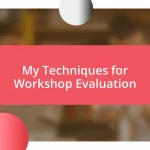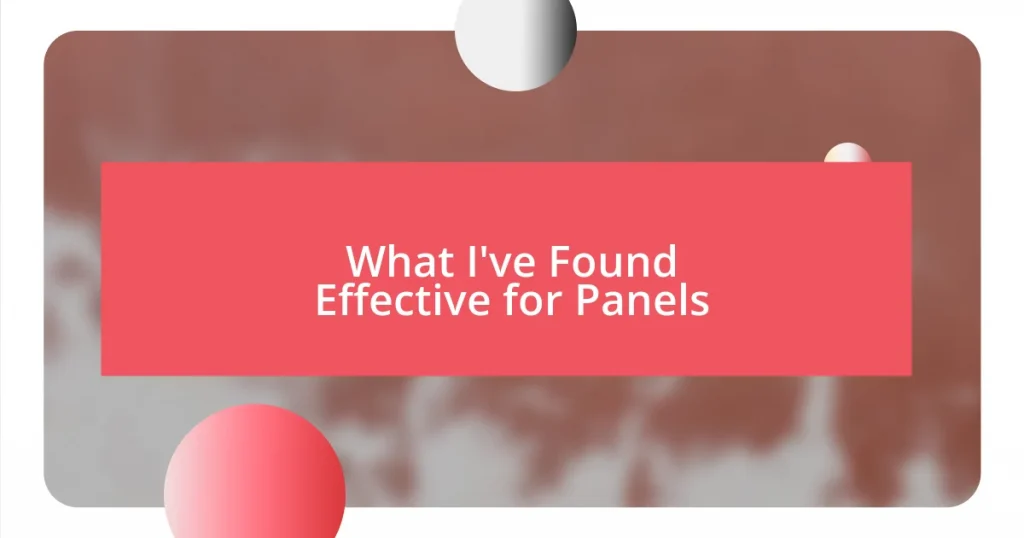Key takeaways:
- Effective collaboration in workshops hinges on creating a safe space for open communication, leading to innovative ideas and stronger relationships.
- Clearly defined roles, such as facilitators and supporters, enhance group dynamics and help leverage each participant’s contributions.
- Continuous improvement relies on gathering feedback, implementing reflective practices, and maintaining ongoing dialogue to foster long-term growth and innovation.

Understanding Collaborative Workshops
Collaborative workshops are spaces where diverse minds come together to share ideas, tackle challenges, and spark creativity. I remember my first workshop—everyone was so engaged, and I was surprised at how quickly different perspectives could reshape our thinking. It made me wonder, how often do we genuinely listen to others in our daily routines?
The essence of these workshops lies in the synergy that develops when individuals contribute their unique expertise. I’ve experienced that magic firsthand; one brainstorming session led to a solution I never would have considered alone. It delights me to think about how our combined efforts can lead to innovative outcomes— isn’t it fascinating how collaboration can turn the mundane into something extraordinary?
Participation and communication are crucial elements of successful collaborative workshops. I often notice that when people feel safe to express their thoughts, the quality of ideas skyrockets. Have you ever been part of a session where one idea ignites passion in others? It’s like watching a spark turn into a flame—love that energy!

Goals of Collaborative Workshops
The primary goal of collaborative workshops is to harness the collective intelligence of participants. During one such workshop I attended, we were tasked with solving a complex problem, and it struck me how ideas flowed effortlessly once everyone felt comfortable sharing. The magic happens when each voice contributes to weaving a richer tapestry of solutions.
Another significant aim is to build stronger relationships among team members. I vividly recall a workshop where we engaged in team-building exercises. Watching colleagues who seldom interacted intimately bond over shared experiences was heartwarming. This deepened relationship not only improved teamwork but also enhanced collaboration in the long run.
Finally, the workshops serve to foster innovation and creativity. I once participated in a session that pushed us outside our comfort zones, and it was exhilarating! As we explored unconventional approaches, we not only uncovered unique solutions but also reignited our passion for our work. It’s moments like these that remind me how collaborative efforts can lead to breakthroughs we never thought possible.
| Goal | Description |
|---|---|
| Harness Collective Intelligence | Utilize diverse perspectives to solve problems collaboratively. |
| Build Relationships | Strengthen connections among participants to boost teamwork. |
| Foster Innovation | Encourage creative thinking and out-of-the-box solutions. |

Planning an Effective Workshop
When planning an effective workshop, it’s vital to have a clear structure in place. I find that outlining the objectives at the outset helps participants stay focused and engaged. In one workshop I organized, we started by defining our goals, and the clarity it provided was remarkable—it let everyone know what we were working toward, creating a sense of purpose right from the start.
- Identify clear objectives: Define what you want to achieve.
- Create a flexible agenda: Allow space for discussion and spontaneity.
- Gather necessary materials: Ensure all tools and resources are prepared.
- Set the right environment: Choose a comfortable, inclusive location.
- Encourage participation: Use icebreakers or engaging activities.
I’ve learned the importance of timing during workshops as well. Keeping track of time can be a challenge, but a well-paced session ensures that all voices are heard without feeling rushed. I vividly remember a workshop that dragged on; the energy faded, and participants became restless. Setting specific time limits for each segment keeps the momentum alive, allowing for diverse contributions while maintaining a dynamic atmosphere.

Techniques for Engagement
Engaging participants in a workshop takes creativity and thoughtfulness. One technique I find effective is using interactive activities, like brainstorming sessions or small group discussions. I remember one workshop where we split into pairs to share ideas; the immediacy of the conversations sparked so much energy that it felt like fireworks were going off! It’s fascinating how breaking into smaller groups allows individuals to voice their thoughts more freely, which can sometimes lead to unexpected breakthroughs.
In my experience, incorporating visual aids can significantly boost engagement. During a recent workshop, I used mind maps and charts to illustrate key concepts. The moment I saw participants nodding along, pointing out connections, and building on each other’s ideas, I felt an immense sense of fulfillment. Visuals can transform abstract ideas into something tangible—do you ever notice how a great image can make a complex idea much clearer?
Lastly, I like to weave in moments of fun and playfulness. For instance, introducing gamified elements, like friendly competitions or quizzes, can keep the atmosphere light. I remember a session where we turned feedback into a game. The laughter and enthusiasm that ensued created a bond among us, making it easier to address serious topics later. It’s intriguing how a little play can transform the dynamics of a workshop. What’s your take on blending fun with serious discussions? I believe it’s a powerful way to enhance learning and connection!

Roles in Collaborative Workshops
In collaborative workshops, clearly defined roles can significantly enhance group dynamics. I’ve found that assigning roles, like a facilitator or a note-taker, helps streamline the process and keeps everyone engaged. For instance, during one workshop, I took on the facilitator role, which allowed me to guide discussions and ensure everyone’s voice was heard—an experience that reinforced the value of shared leadership.
Another important role is the ‘devil’s advocate.’ This person challenges ideas and encourages critical thinking, which can lead to richer discussions. I recall a particularly memorable session where a participant took on this role. Their questions dug deeper into our assumptions and opened up paths to innovative solutions that we hadn’t considered before. Isn’t it fascinating how a little pushback can drive creativity?
Lastly, participants can also be seen as ‘supporters,’ those who actively listen and build on others’ ideas. In one of my workshops, I noticed how one participant’s enthusiastic agreement encouraged another to share their quieter thoughts. This kind of positive reinforcement can create an uplifting environment that fosters collaboration and connection. Have you ever experienced the power of supportive energy in a group setting? It makes such a difference!

Evaluating Workshop Outcomes
Evaluating workshop outcomes is crucial for understanding the effectiveness of our collaborative efforts. After each session, I like to gather feedback through quick surveys or informal conversations. In one workshop, I was pleasantly surprised by a participant’s comment about how the new strategies we discussed transformed their work process. It’s these moments of revelation that remind me the hours of preparation were worth it.
I also find it helpful to revisit our initial goals and see if we’ve hit the mark. I remember reflecting on a session where we aimed to enhance team communication. We ended up achieving that in unexpected ways, like when a quieter team member shared a game-changing strategy during our group discussion. It’s rewarding to see how aligning our outcomes with our intentions can create tangible results.
Lastly, I like to assess the long-term impact of the workshops. Recently, I followed up on a group that attended a problem-solving workshop months later. Many reported not only implementing the strategies discussed but also fostering a culture of open communication that lasted beyond our time together. Have you ever checked in with participants after a workshop? Those follow-ups can be incredibly revealing, both for you and the attendees.

Tips for Continuous Improvement
To foster continuous improvement in collaborative workshops, I emphasize the importance of creating an open feedback culture. After each session, I encourage participants to share their thoughts on what went well and what could be improved, often through an anonymous suggestion box. One memorable instance happened when a participant candidly pointed out that we spent too much time on introductions. This simple insight allowed me to streamline future sessions, making them more efficient and focused. Have you ever considered how a single piece of feedback can transform your approach?
Beyond immediate feedback, I also recommend incorporating reflective practices within the team. In my experience, dedicating a few minutes at the end of each workshop for a quick reflection helps solidify learning. For example, I once had participants jot down one actionable takeaway that they planned to implement after the session. We then shared these insights, leading to an inspiring discussion about diverse applications. This practice not only reinforces commitment but also cultivates a sense of ownership over the collective learning experience.
Lastly, don’t underestimate the power of collaboration beyond the workshops themselves. I often suggest that teams set up regular follow-up meetings to discuss progress on the strategies developed in our sessions. In one case, I saw a team’s creativity blossom when they reconnected to share successes and challenges weeks later. This consistency not only keeps our work alive but also strengthens the bonds formed during our time together. How might you leverage those follow-ups to stimulate ongoing dialogue and growth?















